外研版高中英语选修8全册教案
- 格式:docx
- 大小:153.43 KB
- 文档页数:146
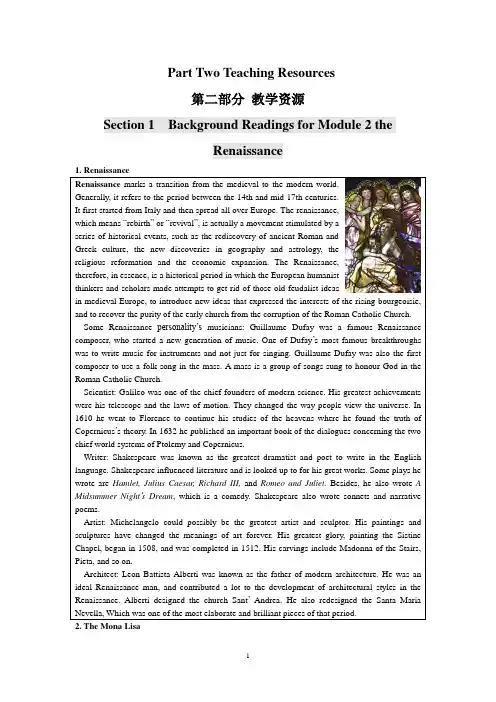
Part Two Teaching Resources第二部分教学资源Section 1 Background Readings for Module 2 theRenaissancein medieval Europe, to introduce new ideas that expressed the interests of the rising bourgeoisie,Section 2 The Analysis of the Difficult Sentences fromModule 2 the Renaissance1….here the taxes depended on the width of the house—so they kept them narrow...……这里按照房子的宽度来征税,所以人们保持房子狭窄……句中出现depend on 短语,意思为“依靠,视……而定”一下就depend一词作一复习讲解。
1)depend作为不及物动词,常与介词on 或upon连用,后接名词或代词,“信赖,依靠”。
如:The people’s lives depend on their crops.You should not listen to rumor (谣言). You can depend on me.2)depend 作“依靠”解,其后接“名词(代词)+ for sth.”。
如:All living things depend on the sun for their growth.3)depend作“相信”解,后接动名词或动名词复合结构。
如:Susan can depend on their arriving here safely.4)depend作“指望”解,后接“sb. + 不定式”。
如:You can’t depend on your enemy to help you.5)depend 作“看……(情况)”解,后接从句。
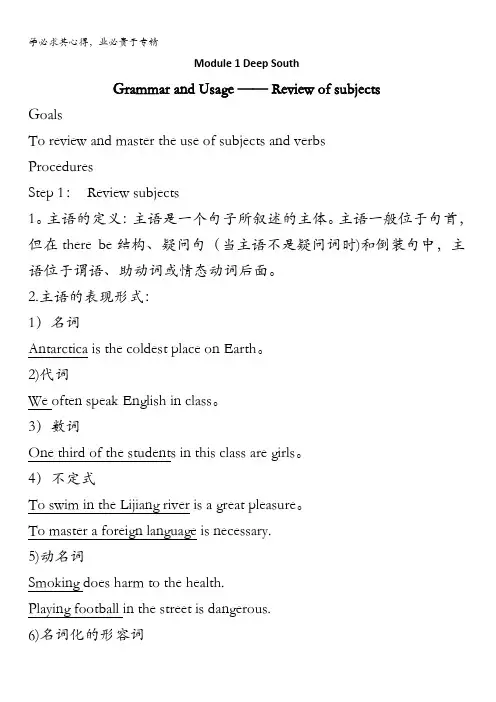
Module 1 Deep SouthGrammar and Usage —— Review of subjectsGoalsTo review and master the use of subjects and verbsProceduresStep 1:Review subjects1。
主语的定义:主语是一个句子所叙述的主体。
主语一般位于句首,但在there be结构、疑问句(当主语不是疑问词时)和倒装句中,主语位于谓语、助动词或情态动词后面。
2.主语的表现形式:1)名词Antarctica is the coldest place on Earth。
2)代词We often speak English in class。
3)数词One third of the students in this class are girls。
4)不定式To swim in the Lijiang river is a great pleasure。
To master a foreign language is necessary.5)动名词Smoking does harm to the health.Playing football in the street is dangerous.6)名词化的形容词The rich are not always happy。
The beautiful is not always good.7)主语从句When we are going to have an English test has not been decided yet。
What the treaty aims to do is to prevent the commercial and military use of the continent。
8)作形式主语It is necessary to master a foreign language。
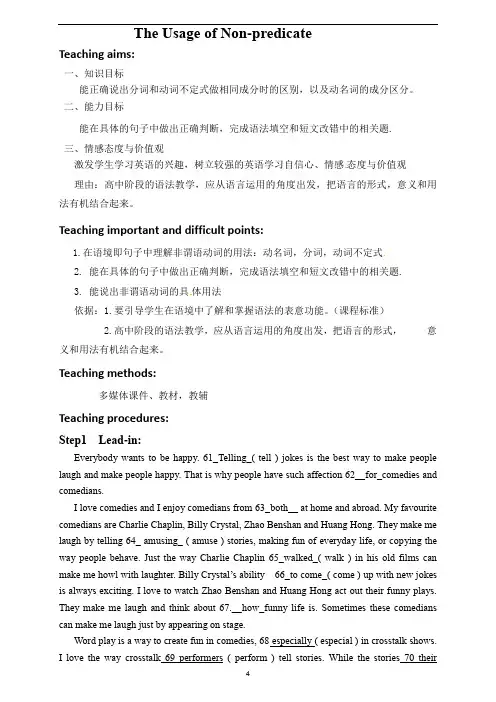
The Usage of Non-predicateTeaching aims:一、知识目标能正确说出分词和动词不定式做相同成分时的区别,以及动名词的成分区分。
二、能力目标能在具体的句子中做出正确判断,完成语法填空和短文改错中的相关题.三、情感态度与价值观激发学生学习英语的兴趣,树立较强的英语学习自信心、情感态度与价值观理由:高中阶段的语法教学,应从语言运用的角度出发,把语言的形式,意义和用法有机结合起来。
Teaching important and difficult points:1.在语境即句子中理解非谓语动词的用法:动名词,分词,动词不定式2. 能在具体的句子中做出正确判断,完成语法填空和短文改错中的相关题.3. 能说出非谓语动词的具体用法依据:1.要引导学生在语境中了解和掌握语法的表意功能。
(课程标准)2.高中阶段的语法教学,应从语言运用的角度出发,把语言的形式,意义和用法有机结合起来。
Teaching methods:多媒体课件、教材,教辅Teaching procedures:Step1 Lead-in:Everybody wants to be happy. 61_Telling_( tell ) jokes is the best way to make people laugh and make people happy. That is why people have such affection 62__for_comedies and comedians.I love comedies and I enjoy comedians from 63_both__ at home and abroad. My favourite comedians are Charlie Chaplin, Billy Crystal, Zhao Benshan and Huang Hong. They make me laugh by telling 64_ amusing_ ( amuse ) stories, making fun of everyday life, or copying the way people behave. Just the way Charlie Chaplin 65_walked_( walk ) in his old films can make me howl with laughter. Billy Crystal’s ability 66_to come_( come ) up with new jokes is always exciting. I love to watch Zhao Benshan and Huang Hong act out their funny plays. They make me laugh and think about 67.__how_funny life is. Sometimes these comedians can make me laugh just by appearing on stage.Word play is a way to create fun in comedies, 68 especially ( especial ) in crosstalk shows.I love the way crosstalk 69 performers ( perform ) tell stories. While the stories 70 their( they ) are often quite funny, their style of speaking is what makes me laugh most of all.Step2 请判断下列句子中划线部分是谓语动词还是非谓语动词。
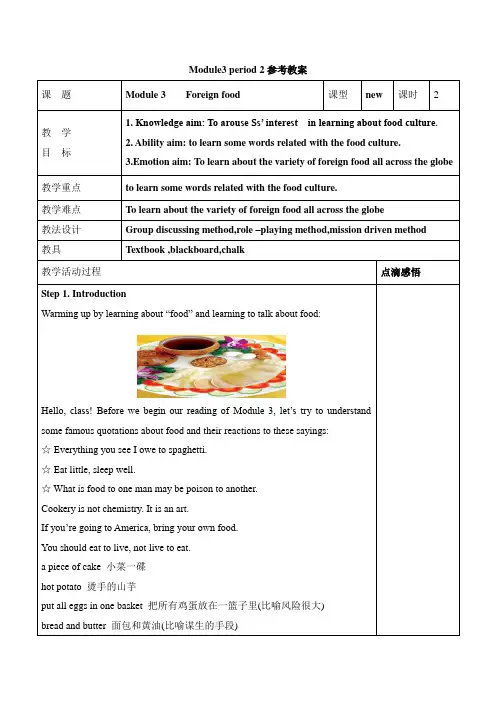
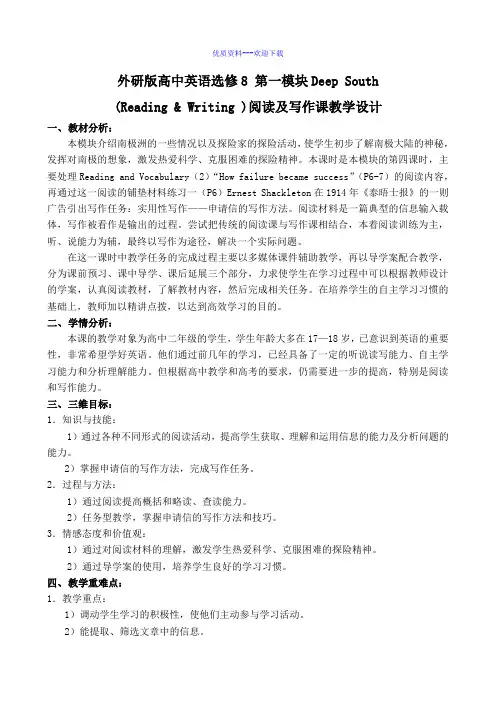
优质资料---欢迎下载外研版高中英语选修8 第一模块Deep South(Reading & Writing )阅读及写作课教学设计一、教材分析:本模块介绍南极洲的一些情况以及探险家的探险活动,使学生初步了解南极大陆的神秘,发挥对南极的想象,激发热爱科学、克服困难的探险精神。
本课时是本模块的第四课时,主要处理Reading and Vocabulary(2)“How failure became success”(P6-7)的阅读内容,再通过这一阅读的铺垫材料练习一(P6)Ernest Shackleton在1914年《泰晤士报》的一则广告引出写作任务:实用性写作——申请信的写作方法。
阅读材料是一篇典型的信息输入载体,写作被看作是输出的过程。
尝试把传统的阅读课与写作课相结合,本着阅读训练为主,听、说能力为辅,最终以写作为途径,解决一个实际问题。
在这一课时中教学任务的完成过程主要以多媒体课件辅助教学,再以导学案配合教学,分为课前预习、课中导学、课后延展三个部分,力求使学生在学习过程中可以根据教师设计的学案,认真阅读教材,了解教材内容,然后完成相关任务。
在培养学生的自主学习习惯的基础上,教师加以精讲点拨,以达到高效学习的目的。
二、学情分析:本课的教学对象为高中二年级的学生,学生年龄大多在17—18岁,已意识到英语的重要性,非常希望学好英语。
他们通过前几年的学习,已经具备了一定的听说读写能力、自主学习能力和分析理解能力。
但根据高中教学和高考的要求,仍需要进一步的提高,特别是阅读和写作能力。
三、三维目标:1.知识与技能:1)通过各种不同形式的阅读活动,提高学生获取、理解和运用信息的能力及分析问题的能力。
2)掌握申请信的写作方法,完成写作任务。
2.过程与方法:1)通过阅读提高概括和略读、查读能力。
2)任务型教学,掌握申请信的写作方法和技巧。
3.情感态度和价值观:1)通过对阅读材料的理解,激发学生热爱科学、克服困难的探险精神。
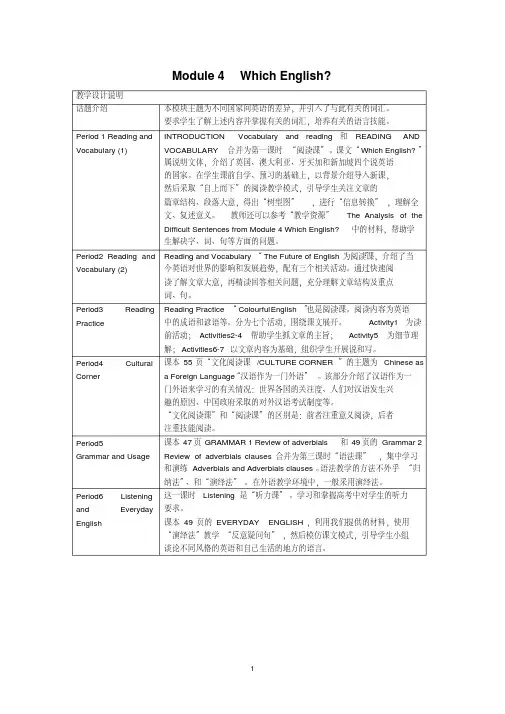
Module 4 Which English?教学设计说明话题介绍本模块主题为不同国家间英语的差异,并引入了与此有关的词汇。
要求学生了解上述内容并掌握有关的词汇,培养有关的语言技能。
Period 1 Reading and Vocabulary (1) INTRODUCTION Vocabulary and reading 和READING AND VOCABULARY合并为第一课时“阅读课”。
课文“Which English?”属说明文体,介绍了英国、澳大利亚、牙买加和新加坡四个说英语的国家。
在学生课前自学、预习的基础上,以背景介绍导入新课,然后采取“自上而下”的阅读教学模式,引导学生关注文章的篇章结构、段落大意,得出“树型图”,进行“信息转换”,理解全文、复述意义。
教师还可以参考“教学资源”The Analysis of the Difficult Sentences from Module 4 Which English?中的材料,帮助学生解决字、词、句等方面的问题。
Period2 Reading and Vocabulary (2) Reading and Vocabulary “The Future of English”为阅读课,介绍了当今英语对世界的影响和发展趋势,配有三个相关活动。
通过快速阅读了解文章大意,再精读回答相关问题,充分理解文章结构及重点词、句。
Period3 Reading Practice Reading Practice “Colourful E nglish” 也是阅读课。
阅读内容为英语中的成语和谚语等。
分为七个活动,围绕课文展开。
Activity1为读前活动;Activities2-4 帮助学生抓文章的主旨;Activity5为细节理解;Activities6-7以文章内容为基础,组织学生开展说和写。
Period4 Cultural Corner 课本55页“文化阅读课/CULTURE CORNER”的主题为Chinese as a Foreign Language“汉语作为一门外语”。
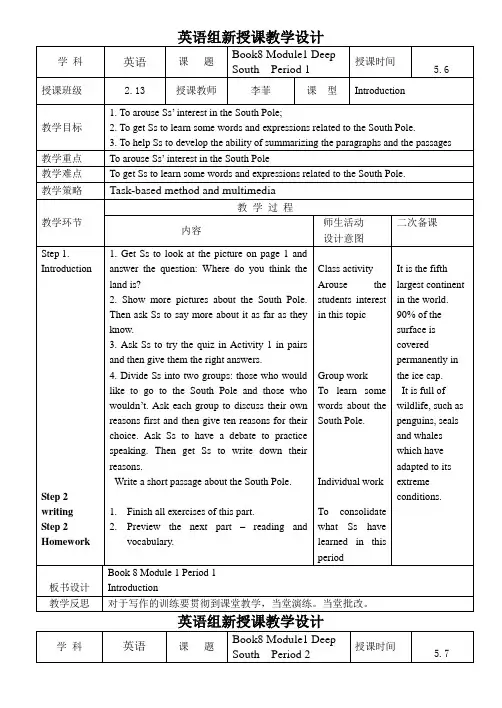
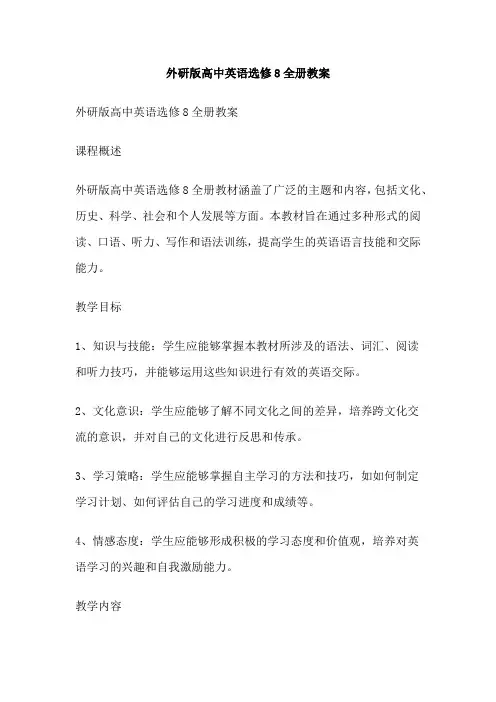
外研版高中英语选修8全册教案外研版高中英语选修8全册教案课程概述外研版高中英语选修8全册教材涵盖了广泛的主题和内容,包括文化、历史、科学、社会和个人发展等方面。
本教材旨在通过多种形式的阅读、口语、听力、写作和语法训练,提高学生的英语语言技能和交际能力。
教学目标1、知识与技能:学生应能够掌握本教材所涉及的语法、词汇、阅读和听力技巧,并能够运用这些知识进行有效的英语交际。
2、文化意识:学生应能够了解不同文化之间的差异,培养跨文化交流的意识,并对自己的文化进行反思和传承。
3、学习策略:学生应能够掌握自主学习的方法和技巧,如如何制定学习计划、如何评估自己的学习进度和成绩等。
4、情感态度:学生应能够形成积极的学习态度和价值观,培养对英语学习的兴趣和自我激励能力。
教学内容本教材共分为10个单元,每个单元都有一个主题,包括:1、Unit 1: Discovering useful words and expressions2、Unit 2: Understanding the meaning of words3、Unit 3: Discovering grammar: Conditionals4、Unit 4: Enjoying literature5、Unit 5: Understanding the world6、Unit 6: Discovering useful words and expressions7、Unit 7: Understanding the meaning of words8、Unit 8: Discovering grammar: Passives9、Unit 9: Enjoying literature10、Unit 10: Understanding the world教学方法1、课堂教学:通过讲解、演示、讨论和互动等方式,使学生掌握本教材所涉及的语法、词汇、阅读和听力技巧。
2、语言实践:通过对话、角色扮演、演讲、写作等活动,培养学生的英语口语和写作能力,同时增强学生的自信心和表达能力。
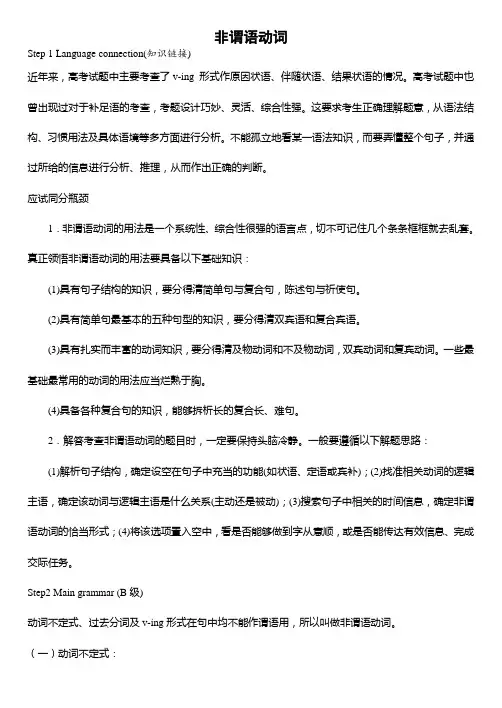
非谓语动词Step 1 Language connection(知识链接)近年来,高考试题中主要考查了v-ing 形式作原因状语、伴随状语、结果状语的情况。
高考试题中也曾出现过对于补足语的考查,考题设计巧妙、灵活、综合性强。
这要求考生正确理解题意,从语法结构、习惯用法及具体语境等多方面进行分析。
不能孤立地看某一语法知识,而要弄懂整个句子,并通过所给的信息进行分析、推理,从而作出正确的判断。
应试同分瓶颈1.非谓语动词的用法是一个系统性、综合性很强的语言点,切不可记住几个条条框框就去乱套。
真正领悟非谓语动词的用法要具备以下基础知识:(1)具有句子结构的知识,要分得清简单句与复合句,陈述句与祈使句。
(2)具有简单句最基本的五种句型的知识,要分得清双宾语和复合宾语。
(3)具有扎实而丰富的动词知识,要分得清及物动词和不及物动词,双宾动词和复宾动词。
一些最基础最常用的动词的用法应当烂熟于胸。
(4)具备各种复合句的知识,能够拆析长的复合长、难句。
2.解答考查非谓语动词的题目时,一定要保持头脑冷静。
一般要遵循以下解题思路:(1)解析句子结构,确定设空在句子中充当的功能(如状语、定语或宾补);(2)找准相关动词的逻辑主语,确定该动词与逻辑主语是什么关系(主动还是被动);(3)搜索句子中相关的时间信息,确定非谓语动词的恰当形式;(4)将该选项置入空中,看是否能够做到字从意顺,或是否能传达有效信息、完成交际任务。
Step2 Main grammar (B级)动词不定式、过去分词及v-ing形式在句中均不能作谓语用,所以叫做非谓语动词。
(一)动词不定式:动词不定式由“to+ 动词原形”构成,如:to study, to play,动词不定式虽然不能作谓语动词用,但仍留着动词的特征,它可以带有所需要的宾语或状语而构成动词不定式短语,如:to study hard, to play table tennis。
动词不定式的基本用法:动词不定式能起名词、形容词和副词的作用,可在句中作主语、表语、宾语补足语、定语和状语用,如:(1)作主语:To help each other is good.(动词不定式作主语时,一般可用it作形式主语,而将作主语的动词不定式置于句末,如:It is good to help each other.(2)作表语:My job is to drive them to the power station every day. 动词不定式在系动词be之后作表语,与表示将来时的be + 动词不定式结构有所区别,如:Our plan is to set up another middle school for the peasants’ children.我们的计划是给农民子弟再成立一所中学。
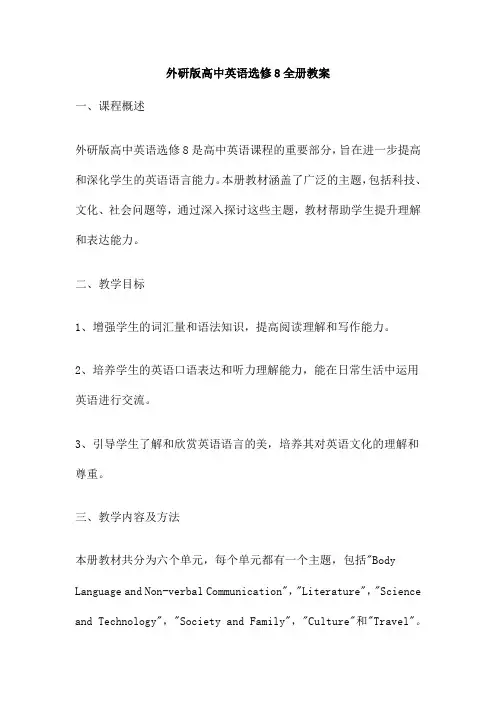
外研版高中英语选修8全册教案一、课程概述外研版高中英语选修8是高中英语课程的重要部分,旨在进一步提高和深化学生的英语语言能力。
本册教材涵盖了广泛的主题,包括科技、文化、社会问题等,通过深入探讨这些主题,教材帮助学生提升理解和表达能力。
二、教学目标1、增强学生的词汇量和语法知识,提高阅读理解和写作能力。
2、培养学生的英语口语表达和听力理解能力,能在日常生活中运用英语进行交流。
3、引导学生了解和欣赏英语语言的美,培养其对英语文化的理解和尊重。
三、教学内容及方法本册教材共分为六个单元,每个单元都有一个主题,包括"Body Language and Non-verbal Communication","Literature","Science and Technology","Society and Family","Culture"和"Travel"。
每个单元都包含了阅读、听力、口语练习、写作、语法学习等环节。
教学方法包括:1、激活学生的前知:通过提问和讨论的方式,了解学生对主题的熟悉程度和已有的知识。
2、教学策略:采用讲解、示范、小组讨论、角色扮演等多种教学方法,以提高学生的参与度和学习效果。
3、学生活动:组织学生进行小组讨论、角色扮演等活动,以增强他们的口语表达和听力理解能力。
4、评估与反馈:通过作业、测试和课堂表现等方式,评估学生的学习效果,并及时给予反馈和建议。
四、教学重点与难点教学重点包括:1、深入理解和探讨每个单元的主题。
2、提高学生的阅读理解和写作能力。
3、培养学生的英语口语表达和听力理解能力。
教学难点包括:1、帮助学生克服在英语表达中的语法和词汇障碍。
2、引导学生了解和欣赏英语语言的美,培养其对英语文化的理解和尊重。
3、通过多样化的教学活动激发学生的学习兴趣和积极性。
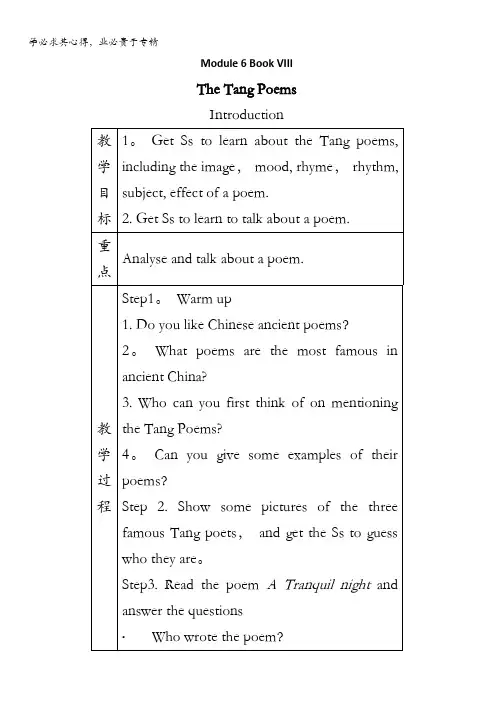
Module 1 Deep SouthIntroduction and Reading -- Antarctica: the Last Continent Goals●To learn something about the North pole and South pole●To learn to read with strategies●To learn and master some useful words and expressions in the textProceduresStep 1: Warming up1. Warming up by questionsHello, class. Today we’re going to learn Module 1. This module is a common knowledge about Antarctica. Well, do you know the differences between the South Pole and the North Pole? Now let’s try a quick quiz. Work in pairs and find out the differences between the South Pole and the North Pole.2. Warming up by studying new wordsBefore we read the text, we should firstly study some new words which appear in the passage. Well, look at these words and try to read them, and then practice the spelling exercises.Spelling exercises 1. Do you know the ______(一年的) course of the sun?2. The well is ten meters in d______.3. France made a peace t________ with a neighboring country.4. She left her purse on the table as a t_____ of the child’s honesty.5. The house was in a dirty _____(状况)6. The football team was ____(晋升) to the first division.7. She _____(适应) herself quickly to the new climate.Step 2: Reading1. Reading and find a heading for each paragraph2. A text organization of Antarctica3. Reading and answering questions1. Which of the following sentences is WRONG about Antarctica?A. Antarctica is not only the coldest place but also the driest place on earth.B. Antarctica is the fifth largest continent in the worldC. A high mountain range, the Trans-Antarctica range, cuts the continent in twoD. Antarctica holds 70% of the world’s ice and 90% of the world’s fresh water.2. Which of the following descriptions is RIGHT about the wild life in Antarctica?A. There are flying birds, seals, whales and one type of penguins.B. The long Antarctica winter night, the extreme cold and lack of rainfall make few types of penguins.C. There are some trees on the large continent.D. Only two types of flowering plants are found and no forms of algae can grow on ice.3. Antarctica rocks are very important for research because ______.A. the rock has become a window on the pastB. gases and minerals trapped in the rocks can tell us a lot about the weather in the pastC. most of the rocks are meteorites from outer spaceD. most Antarctica rocks are dark in color4. _________crossed the Antarctica Circle in the late 18th century.A. The British explored James CookB. The explorer called NorwegianC. The explorer called CarstensD. The explorer called Borchgrevink4. Complete the article with one word in each blankAntarctica is the coldest and driest place in the world. It is technically a _______. It _____ 90% of the wo rld’s ice and most of its fresh water is in a frozen _______. In some places it reaches a ________ of five kilometers.The wildlife in Antarctica has ____ its extreme conditions, but few types of plants can survive there because of the long winter night, the extreme cold and _____ of rainfall.Researchers can get a lot of ________ from the ice, gases, minerals and rocks there. Rocks in dark color which ______ ______ against the white are easy to find and collect.In 1895, a Norwegian called Carstens Borchgrevink became the first man to ____ ___ _____ the Antarctica mainland. Today scientists from many countries travel to Antarctica to study its _________. A spirit of international friendship has replaced the _________. In 1961, 12 countries signed a ________, making Antarctica the world’s biggest nature reserve. Antarctica has become perhaps the most successful symbol of man’s efforts to work together for progress and peace.Step 3: Useful ExpressionsStep 4: After reading1. Why is Antarctica an important place?2. Do you think the Antarctica Treaty is a good idea? Why / Why not?3. What might happen to Antarctica if there wasn’t an international treaty to protect it?4. What other international treaties do you know about ?5. What other international treaties do you think the world needs?。
外研版高中英语必修8 全册教学设计教案目录Module 1 Deep South Period IIModule 1 Deep South Period IIIModule 1 Deep South Period IVModule 1 Deep South Period VModule 1 Deep South Period VIModule 1 Deep South Period ⅠModule 1《Deep South》Module 2 The Renaissance--cultural corner and taskModule 2 The Renaissance--function and grammarModule 2 The Renaissance--reading and vocabulary 1Module 2 The Renaissance--reading practiceModule 2 The Renaissance--Vocabulary and writingModule 2 The Renaissance--word list and introductionModule 3 Foreign Food--function and grammarModule 3 Foreign Food--reading and vocabularyModule 3 Foreign Food--reading practiceModule 3 Foreign Food--vocabulary and writingModule 3 Foreign Food--word list and introductionModule 4 Which English--Cultural cornerModule 4 Which English--GrammarModule 4 Which English--IntroductionModule 4 Which English--Listening Everyday English Speaking Module 4 Which English--Reading and VocabularyModule 4 Which English--Reading PracticeModule 4 Which English--Speaking-Reading and Vocabulary(2)-Writing-TaskModule 5 The Conquest of the Universe-- Introduction Reading and speakingModule 5 The Conquest of the Universe-- Listening Everyday English SpeakingModule 5 The Conquest of the Universe-- Reading and Vocabulary Module 5 The Conquest of the Universe--GrammarModule 5 The Conquest of the Universe--Reading and Vocabulary (2) Writing TaskModule 5 The Conquest of the Universe--Reading PracticeModule 6 《War and Peace-grammer》Module 6《The Tang Poems-Introduction》Module 6《The Tang Poems-Language Points》Module 6《The Tang Poems-Reading and writing》BooK 8 Module 1 Deep South Period Ⅰ教案设计Introduction & Reading and Vocabulary (1)教学目标:了解神秘的南极大陆。
教学重点:学习和初步运用有关词语,回答有关南极大陆的各种问题。
教学难点:通过阅读提高概括和略读、查读能力。
Step1: Lead-inIt is well-known to all that seven continents exist on the earth. Which one was the last continent to be discovered? (Antarctica)It is its unique natural features and scientific research value that attract interests of many tourists, explorers and scientists. As the exploration goes on, people know more and more about Antarctica. How much do you know about it? Ok, let’s have an Antarctic general knowledge quiz.①which month is the coldest month in Antarctica?(September, July, December )②Generally a penguin weighs about .(1 kg, 5 kg, 50 kg )③The China Great Wall Statio n was founded .(in 1985, in 1989)④The blood colour of fishes in Antarctica is .(brown, red, blue, white)⑤What is the southernmost point of The Earth?(the south pole /deep south)Opposite the south pole is the north pole. what are the similarities and differences between the north pole and the south pole?Let’s go on with the quick quiz.Step2: Introduction Activity 1Step3: Reading and Vocabulary (1)Since Antarctica is so fantastic, why not learn more details about it through reading?1.Text analysis2. Activities 2—5BooK 8 Module 1 Deep South Period II 教案设计Language points in Introduction & Reading and vocabulary (1) Language Points in Introduction1. polar adj.(1)(南、北)极的,地极的,近地极的e.g. the polar regions(2)磁极的e.g. polar attraction 极向引力2. pole n. 地极e.g. the North/South Pole3. quiz [c] 竞赛,比赛(尤指电视或电台中人们竞相回答问题以测验其知识者)e.g. take part in a quiz, a sports/music/general knowledge quizvt. 问某人问题e.g. quiz sb about sb/sth4. explore vt(i) (1)探险(测),考察e.g. explore the Arctic regions, explore the new continentvt. (为测试或了解)仔细检查,探索(究)e.g. explore the solution to the problemn. explorationn. explorerLanguage Points in Reading and Vocabulary1. range: (1) (山、丘等)连贯而成的脉,排, 列, 行e.g. a mountain-range(2)成套或成系列的东西、种类e.g. a range of tools/foods, have a wide / narrow range of interests, hobbies(3)限度,范围e.g. This subject is outside my range.2. imagine vt. 想像,设想imagine (1)that: Imagine that you are a university student.(2)sb/sb’s doing sth: imagine me/my doing it(3)sb/sth+(to be)+adj.: imagine her to be beautiful(4)sb/sth + as + n.: imagine him as a tall man(5)doing sth3. adapt vt. (1)adapt sth for sth 使某事物适合新的用途、情况等/修改某事物This machine has been specially adapted for use underwater.这机器是为水下使用而特别改装的。
These styles can be adapted to suit individual tastes.这些式样均可改动以适应个人不同的爱好。
(2)adapt sth for sth (from sth) (为电视、舞台等)改编或改写This novel has been adapted for radio from the Russian original.这部小说已由俄文原著改编成无线电广播节目。
(3)adapt oneself to sth使自己适应adapt himself to the new environment/climaten. adaptationadj. adaptable4. survive vi. 生存,幸存 vt. (1)经历(某事物)幸存survive an earthquake (经历地震而死里逃生)(2)比……活得长She survived her husband for ten years.n. survivaln. survivor5. stand out (from/against sth) 突出/显眼e.g. Red stands out against a white background. 白底衬着红色特别醒目。